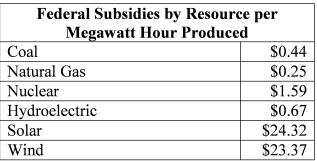Putting utilities on the dole
Why subsidies for renewable energy are a bad idea
- Thursday, September 25, 2008
Nevada Senator Harry Reid is among those pushing a bill through Congress that would extend the federal government's biggest subsidy for renewable energy sources – the Production Tax Credits program.
Concentrated solar power plants are very dependent upon federal tax credits that lapse at the end of this year," says Robert Boehm, director of UNLV's Center for Solar Energy Research. "If they're not renewed, it will have a chilling effect on the industry."
Indeed, this can be said of most renewable energy sources, as they all depend on government use of taxpayer money for survival.

A recent study by the Energy Information Administration at the U.S. Department of Energy analyzed the cost of the subsidies that the federal government gives to each electricity-generating source. The report demonstrates how much more dependent certain renewable energy technologies are on government support than are traditional energy resources. For each megawatt hour of electricity produced, wind and solar power receive more than $20 of government handouts, whereas natural gas receives only 25 cents.
Despite government generosity toward solar and wind developers, electricity generated by these resources is still hugely more expensive. Often, the cost of electricity from these resources is so expensive that, for it even to exist, state governments must mandate by law that people buy it.
Nevada has such a law, requiring that Nevadans by 2015 purchase 15 percent of their electricity from expensive renewable sources. Generally, the additional cost for complying with this law is funded through a hidden charge in electricity rates.
Policymakers who force their constituents to pay for such outrageous subsidies often cite two rationales. First, they claim that renewable energy sources such as solar and wind power will reduce the United States' dependence on foreign oil. However, the Energy Information Administration's data on electricity generation shows that only 1.58 percent of all electricity generated comes from petroleum sources. Wind and solar power are sources of electricity – not fuel. With regard to electricity, the United States is already energy independent.
Second, policymakers assert that large subsidies for renewable energy will lead to job creation in green technologies. Senator Reid has said that legislation to extend the Production Tax Credit "will create tens of thousands of jobs in Nevada and more than a million nationally." This is likely true. Less efficient production processes are often more labor intensive.
It is also true that job creation in green technologies will come at the expense of jobs in more productive sectors in the economy. Labor and financial resources will be siphoned away from companies that produce things such as food, computers or automobiles. As resources are taken away from these industries and used to subsidize an inefficient means of energy production, the price of these products will climb and the quality of life for all Americans will decline.
Some renewable energy advocates rationalize these policies with overly optimistic attitudes about the price of solar energy declining dramatically at some future date. However, this is unlikely. The primary chemical input into production of solar panels is polysilicon – the same material that is used to manufacture microprocessors. As demand for solar panel production increases and supplies of polysilicon remain limited, the result is a global shortage. Over the past five years the material's price has increased from $20 to $300 per kilogram, and it continues to rise.
The government mandates and subsidies for solar power will undoubtedly cause this trend to accelerate. Yet the assumption that humanity will benefit more from solar panels than from microprocessors is very presumptuous, to say the least.
Federal and state policymakers should get their facts straight about renewable energy resources before committing billions of taxpayer dollars in subsidies. Wind and solar power add nothing but cost and instability to the electric grid.
"We already have electricity coming out of everybody's wall socket," Nathan Lewis of Caltech's Powering the Planet project noted last year. "This is not a new function we're seeking. It's a substitution.
"It's not like NASA sending a man to the moon. It's like finding a new way to send a man to the moon when Southwest Airlines is already flying there every hour handing out peanuts."
Geoffrey Lawrence is a fiscal policy analyst at the Nevada Policy Research Institute.





